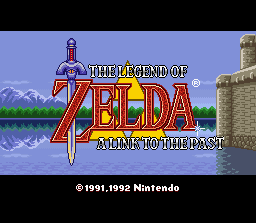
Playing through Skyward Sword has inspired me to take a closer look at the other Zelda games that I hold in such high esteem. Friends and strangers alike meet my praises of A Link to the Past with polite smiles, nods, and reminders that nostalgia is a powerful force. So I decided it’s time I take a careful look at the game and see how it holds up against my complaints against Skyward Sword.
Upon starting a new game one of the first things I noticed was that I could quickly advance the storyline text and I didn’t have to read everything if I didn’t want to.
Now, I’ve played the game several times, so I know exactly where to go and what to do, at least for these initial stages. But even my first time playing, I was able to pick on this pretty quickly. (You know, back when I was 11…)
After taking the stairs down to rescue the princess, my brother and I were immediately amazed at the fantastic game design. A design one would expect more from Valve than from Nintendo, if the recent Zelda games are any indication.
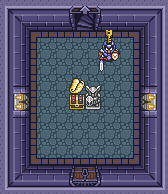
The first challenge you encounter is a locked door. The room contains a bad guy (which you may have some experience with at this point, or you may not). Either way you need to kill him. The room also contains a chest. By this point you have had two opportunities to open different chests, so you should probably be familiar with the concept, but now we learn that maps are items you can get from chests.
The next room gives you a taste for what it’s like to fall off the edge and provides a small indication that you can throw pots as weapons. Standard dungeon behaviors.
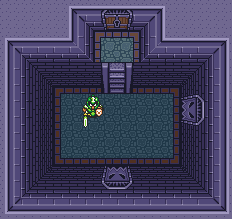
The next room provides a new learning puzzle. Once you enter, the doors lock, leaving you face to face with a guard. Killing the guard opens the door. This will be helpful to know later.
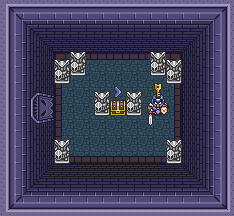
The room to the right contains another guard, who drops a key when killed, and a chest. The chest contains the second big item in the game. The boomerang. Unlike the new “modern” Zelda games, the instructions for the boomerang are extremely succinct.
“You got the Boomerang!
Give it a try! (To select an
item, press the Start Button.)”
(That’s why I love this game.)

Heading down a few more flights of stairs, we reach the first enemy of any importance. After a little careful fighting (or throwing two of the three provided pots) you kill the guard and get the big key and can rescue Zelda.
…a few minutes later…
You find yourself in the throne room. One of the few times Zelda stops you to give you advice, she tells you which way to push the ornamental shelf.
The next room help you to realize your ability to light torches with your lantern and show you how it uses up magic power. (Note, at this point we have not had to earn, gain, or achieve magic power, we have it from the start.)
The next few rooms are pretty standard. The baddies make it a slight challenge by running into you and taking health. The puzzles are typical find a key, door, or both.
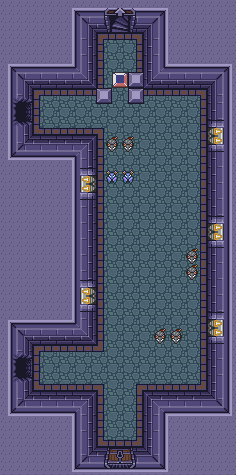
Several rooms later, we encounter two new things we have not seen before. The first is cracks in the wall on the left. We can’t do anything about them at this point, but now we know that maybe we should come back at some later point. The second obstacle is a set of four stone blocks. Simply push the one in the middle and you can walk right through, but now we know about block moving challenges.
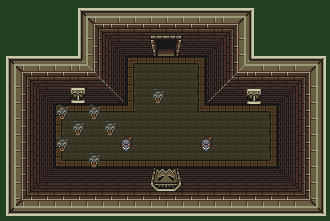
Head up the stairs, through another room and come to the final challenge. Again Zelda stops you (I think for only the third time) and tells you which lever to pull. If you pull the wrong one, snakes fall from the ceiling. If you obey, the door opens and you finish the initiation task.
Here we find out a little bit more of the story line, but again it’s skippable if desired, and you can claim your heart as a reward.

That finishes up the inaugural mission of a Link to the Past.
So What Did We Learn?
- We learned how to open locked doors by finding keys, either in chests or by killing foes.
- We learned killing all the enemies in a room can open a door if it’s not locked by a key.
- We (optionally) learned to use a boomerang and found out it freezes some enemies, and we can grab things with it.
- We learned about magic powder.
- We learned about torches.
- We learned about pushing blocks.
- We learned about lever pulling.
- We learned who Zelda is, what she looks like, and where we can find her later in the game.
This is how games *should* work. You shouldn’t need multiple text boxes, alerts, popups, conversations, and cutscenes about every new little detail and operation. If the game is laid out properly, the gamer will learn to play as they go along. If a player doesn’t care about the story line, they should be allowed to skip it.
I blame the complicated controls. If Nintendo wasn’t making each new controller more convoluted than the last, we wouldn’t need to read a manual every time we get a new weapon. But hey, that’s just me. Maybe you like to read your video games.
(Special thanks to Ian Albert for the Zelda Map Dumps.)